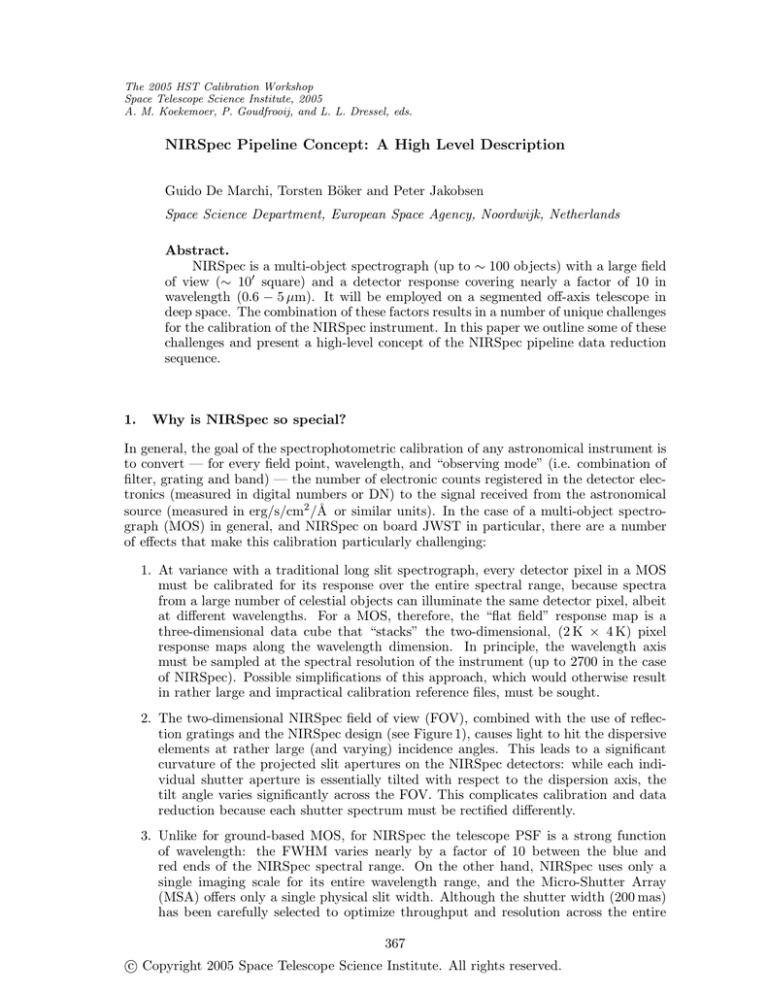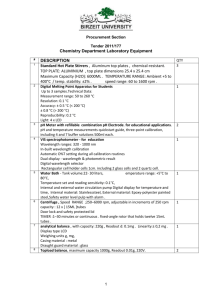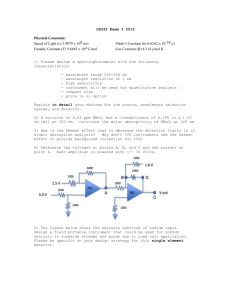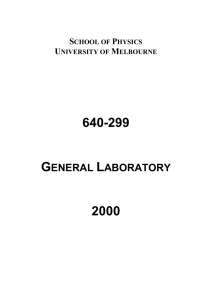
The 2005 HST Calibration Workshop
Space Telescope Science Institute, 2005
A. M. Koekemoer, P. Goudfrooij, and L. L. Dressel, eds.
NIRSpec Pipeline Concept: A High Level Description
Guido De Marchi, Torsten Böker and Peter Jakobsen
Space Science Department, European Space Agency, Noordwijk, Netherlands
Abstract.
NIRSpec is a multi-object spectrograph (up to ∼ 100 objects) with a large field
of view (∼ 100 square) and a detector response covering nearly a factor of 10 in
wavelength (0.6 − 5 µm). It will be employed on a segmented off-axis telescope in
deep space. The combination of these factors results in a number of unique challenges
for the calibration of the NIRSpec instrument. In this paper we outline some of these
challenges and present a high-level concept of the NIRSpec pipeline data reduction
sequence.
1.
Why is NIRSpec so special?
In general, the goal of the spectrophotometric calibration of any astronomical instrument is
to convert — for every field point, wavelength, and “observing mode” (i.e. combination of
filter, grating and band) — the number of electronic counts registered in the detector electronics (measured in digital numbers or DN) to the signal received from the astronomical
source (measured in erg/s/cm2 /Å or similar units). In the case of a multi-object spectrograph (MOS) in general, and NIRSpec on board JWST in particular, there are a number
of effects that make this calibration particularly challenging:
1. At variance with a traditional long slit spectrograph, every detector pixel in a MOS
must be calibrated for its response over the entire spectral range, because spectra
from a large number of celestial objects can illuminate the same detector pixel, albeit
at different wavelengths. For a MOS, therefore, the “flat field” response map is a
three-dimensional data cube that “stacks” the two-dimensional, (2 K × 4 K) pixel
response maps along the wavelength dimension. In principle, the wavelength axis
must be sampled at the spectral resolution of the instrument (up to 2700 in the case
of NIRSpec). Possible simplifications of this approach, which would otherwise result
in rather large and impractical calibration reference files, must be sought.
2. The two-dimensional NIRSpec field of view (FOV), combined with the use of reflection gratings and the NIRSpec design (see Figure 1), causes light to hit the dispersive
elements at rather large (and varying) incidence angles. This leads to a significant
curvature of the projected slit apertures on the NIRSpec detectors: while each individual shutter aperture is essentially tilted with respect to the dispersion axis, the
tilt angle varies significantly across the FOV. This complicates calibration and data
reduction because each shutter spectrum must be rectified differently.
3. Unlike for ground-based MOS, for NIRSpec the telescope PSF is a strong function
of wavelength: the FWHM varies nearly by a factor of 10 between the blue and
red ends of the NIRSpec spectral range. On the other hand, NIRSpec uses only a
single imaging scale for its entire wavelength range, and the Micro-Shutter Array
(MSA) offers only a single physical slit width. Although the shutter width (200 mas)
has been carefully selected to optimize throughput and resolution across the entire
367
c Copyright 2005 Space Telescope Science Institute. All rights reserved.
368
De Marchi, Böker & Jakobsen
Figure 1: NIRSpec optical layout.
spectral range, the fraction of light that passes through an MSA shutter (or fixed
slit) is nevertheless a strong function of wavelength. In principle, the slit throughput
can be accurately modeled, but this approach requires exact knowledge of the source
shape and position within the shutter. Given the faintness of targets and the limited
accuracy of the target acquisition process, such a priori knowledge is not generally
available. Note that the slit loss variations with wavelength are most pronounced for
a point source, while in the case of a source that uniformly illuminates the entire
shutter or slit, a very small correction for chromatic slit loss is needed. Another effect
that has consequences similar to those of chromatic slit loss are diffraction losses due
to the finite size of the NIRSpec optics behind the MSA, in particular the gratings.
The diffraction pattern depends on wavelength, source shape and position within the
slit, and thus the amount of light that is diffracted outside the NIRSpec optical train
is difficult to predict. Because both these effects — the geometric light loss due to
“cutting off” the PSF at the shutter/slit, and the diffraction losses in the optical train
behind the MSA — have similar consequences, we refer to them here collectively as
“chromatic slit loss”.
NIRSpec Pipeline Concept
369
4. Because of the large field of view, use of a purely reflective optical train, and deployment behind a fast, off-axis telescope, optical distortion is significant in NIRSpec.
The resulting plate-scale variations across the aperture provide additional challenges
for the spectrophotometric calibration because one must account for the varying solid
angle seen by both detector pixels and MSA shutters.
The complexity of the effects discussed above, combined with the limited testing facilities on ground and stringent efficiency requirements in orbit, leads to an approach for
NIRSpec calibration which relies heavily on optical modeling of the instrument. Wherever
possible, we will attempt to construct parametric descriptions of the instrument features
that will be tested, verified, and optimized at every stage from sub-system to instrument
level to in flight operations. The requirements for the instrument performance simulator
are thus intimately connected to the design of the NIRSpec pipeline.
Here we provide a brief, high level summary of the steps involved in processing NIRSpec
spectra. In particular, we address the operations that must be carried out on raw data to
render them in a form suitable for scientific analysis.
2.
Pipeline goals
The main product of the NIRSpec pipeline is a rectified, finely sampled “window” for each
open MSA shutter. This window is a two-dimensional array, sized to capture all the (dispersed) light entering the collimator/camera optics through the shutter under consideration
for the specific observing mode. Once processed by the pipeline, all rows in the final extraction window have the same, uniform wavelength scale, i.e. all columns correspond to
the same wavelength and the spectral sampling is constant along rows and the same for
all extraction windows belonging to a common observing mode. The value of each element
(pixel) in the window is the astrophysical flux, calibrated in absolute terms. It should
be noted that there is no one-to-one correspondence between array elements in the final
extraction window and detector pixels.
One extraction window is produced for each open shutter, regardless whether it contains objects or background, but each window is marked accordingly on the basis of the
information provided by the observer. The correct procedure to subtract background light
depends on the size and shape of the source, as well as on the structure and spectrum of its
surroundings. Therefore, background subtraction from the extracted spectra is left to the
observer, who will select the background windows most suitable to his needs. However, for
quick-look purposes, the pipeline computes an average background by combining all available background windows, or only those specifically associated by the observer to one target,
and subtracts it from the extracted object spectrum. The window is then collapsed in the
spatial direction and a one-dimensional spectrum is produced, which is further corrected to
compensate for the chromatic slit loss (using the correction computed for a point source).
Since, however, the latter correction depends crucially on the geometry of the target and
on its exact position within the slit, the produced one-dimensional spectrum should only be
used for a first assessment of the overall quality of the data (quick-look). Scientific analysis
should be carried out on the full two-dimensional final extraction window.
3.
The NIRSpec pipeline
The pipeline is a series of operations that need to be carried out on detector raw data to
remove instrumental signatures and to convert counts to absolute flux units. For NIRSpec,
and MOS instruments in general, it is convenient to split these operations in two groups:
1) those that depend solely on pixel coordinates on the detector; 2) those that depend on
370
De Marchi, Böker & Jakobsen
pixel coordinates, wavelength of the incident light and location of the (undispersed) source
in the field of view.
The first group includes dark current, linearity and bias level corrections, all of which
are independent of the disperser and filter used, as well as pixel-to-pixel variations in the response of the detector (hereafter “P-flat”), for which the wavelength dependence is expected
to be negligible within each passband, as suggested by preliminary analyses. Operations belonging to this group can be applied to the raw data frame as a whole and are not discussed
further here because they are all similar to those routinely carried out for the instruments
on board the HST.
The second group includes corrections for sensitivity variations (on both global and
local scale), geometric distortion (affecting the flux, spatial scale and wavelength of each
pixel) and absolute flux calibration. Operations of this type are more logically executed at
the level of the extraction window because they depend on which specific MSA shutter is
used. These steps are conceptually not different from those normally carried out with traditional ground-based single and multi-object spectrographs, and include: removing large
scale variations in the uniformity of the detector’s response, both as a function of position and wavelength (usually referred to as L-flat); tracing the spectrum in the aperture
and rectifying the wavelength scale and the spatial axis (spectral extraction); assigning a
wavelength to each pixel in the extracted spectrum (wavelength calibration); correcting the
measured count rate to account for field and wavelength variations in the throughput of
the optics and dispersing elements, such as the grating blaze function (flux calibration);
registering the measured count rates with those of a reference spectrophotometric standard
(absolute calibration).
In reality, however, the complexity of NIRSpec (see Introduction) and the constraints
imposed by having the MSA in the optical train have serious repercussions on the pipeline
flow and on the calibration of the instrument, both on the ground and in orbit. In particular,
some of the steps in the second group indicated above must be carried out simultaneously,
since they require calibration measurements that are intertwined and cannot be otherwise
obtained separately.
An example of two calibration steps that must be executed together is the correction for
large scale flat field uniformity and throughput variations. The former is the so called L-flat,
i.e. the measure of the low-frequency variations in the response of the detector, whereas the
term ‘throughput’ here refers to the transmission of all the reflective and dispersive elements
along the optical path. Both depend on field angle (or pixel position) and wavelength, and
both are characterized during ground calibration of the individual components and at the
integration level. This calibration information could in principle be used to determine the
total sensitivity as a function of wavelength and field angle for any observing mode. However, while the wavelength dependence can be accurately described by a model, validated
by ground calibration measurements, the dependence of the throughput on field angle is
much more difficult to predict analytically and will have to be determined empirically. Furthermore, such a determination requires a proper knowledge of the L-flat, which may not
be attainable with the required level of accuracy during ground calibration (because, after
integration, the detectors cannot be uniformly illuminated due to the presence of the MSA
in the optical path).
It is, therefore, advisable to determine simultaneously the combined effect of throughput and detector response on the overall sensitivity variations of the instrument, as a function of wavelength and field position, since they collectively affect the response of each
pixel as a function of wavelength. To this purpose, NIRSpec is equipped with an internal
continuum calibration lamp, of known spectrum, that uniformly illuminates the MSA. The
lamp can be used to simultaneously measure on the detector, during thermal vacuum and
in flight, the combined response (i.e. DQE + throughput) as a function of wavelength and
position. Time constraints do not permit such measurements to be obtained for each individual shutter, but a suitable subsample may be sufficient. The result would be a series of
NIRSpec Pipeline Concept
371
extraction windows uniformly spread across the detector, each containing the same known
spectrum, which completely cover the detector at least for some wavelengths.
With measurements of this type, it is possible to derive the low-frequency detector
response variation, both spatial and spectral, folded with the low frequency spectral and
field variation of the throughput. It is useful to visualize this calibration file in the form
of a three-dimensional array, with X and Y along the detector’s coordinates and Z scaling
with wavelength. Since it is expected that any variations in the overall instrument response,
with position or wavelength, are very slow and thus suitable to be interpolated via a loworder polynomial, it is only necessary for the pipeline to know the form and parameters of
this function in order to apply the correction. The advantage of the approach mentioned
above, over the separate measurement of the detector L-flat and individual throughput of
the components, is that it can be easily repeated in flight, for a subset of the exposures, to
verify the temporal stability of the sensitivity.
4.
Conclusions
Although space limitations do not allow us to address in detail the many individual tasks
of the NIRSpec pipeline, we offer in Figure 2 a schematic conceptual outline of the steps
needed to deal with the MSA data. It is obvious from the complexity of the tasks at stake
that, in order to efficiently carry out the calibration of the NIRSpec data, an innovative
approach will be needed that departs in more ways than one from that routinely used for
HST data. In particular, the pipeline will have to rely more heavily on optical modeling of
the instrument and the reference files will, in most cases, be replaced by tables of coefficients
that represent the best fitting parameters of those models. Furthermore, the multiplicity
of observing modes makes it almost impossible to test and derive reference files for each
and every observational setup during the ground campaign. Therefore, developing and
validating an end-to-end simulator of the scientific performances of NIRSpec becomes a
pressing need in order to pave the road to the smooth and manageable commissioning and
calibration of the instrument.
Acknowledgments.
this topic.
We are grateful to Pierre Ferruit for very useful discussions on
372
De Marchi, Böker & Jakobsen
Figure 2: Schematic conceptual outline of the NIRSpec pipeline.







